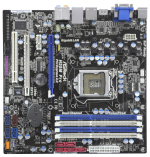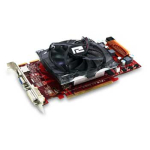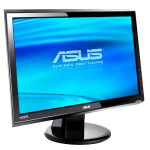System Buyers' Guide: PCs for Under $1000
by Sean Hollister on February 12, 2010 2:00 AM EST- Posted in
- Guides
Intel Mainstream PC
If you have a bit more to spend, the next step up the pricing ladder brings a lot to the table: the Intel Core i3-530, a best-in-class H55 motherboard, a 1080p LCD monitor and a bang-for-the-buck GPU to power it. Now we're talking.
| Intel Mainstream System | ||
| Hardware | Component | Price |
| Processor | Intel Core i3-530 (2.93GHz x2, 32nm, 4MB L3 Cache) |
$120 |
| Cooling | CPU Retail HSF | $0 |
| Video | PowerColor Radeon HD 4850 512MB | $100 |
| Motherboard | ASRock H55M Pro LGA1156 Micro ATX | $95 |
| Memory | G.Skill Ripjaws 4GB DDR3-1600 F3-12800CL9D-4GBRL | $105 |
| Hard Drive | WD Caviar Blue 500GB WD5000AAKS | $54 |
| Optical Drive | Sony Optiarc Model AD-7240S-OB 24X DVDRW SATA | $28 |
| Audio | Onboard | $0 |
| Case | Cooler Master Centurion 5 CAC-T05-UW Mid Tower ATX | $55 |
| Power Supply | OCZ ModXStream Pro 500W ATX12V SLI Certified, CrossFire Ready, 80 PLUS Certified Modular Active PFC (before $25 Rebate) | $65 |
| Base System Total | $622 | |
| Display | ASUS VH226H Black 21.5" 2ms(GTG) HDMI Widescreen 16:9 LCD (1920x1080) (before $20 Rebate) | $170 |
| Speakers | Cyber Acoustics CA-3090 26W 2.1 Speakers | $21 |
| Input | Microsoft B2L-00045 Comfort Curve Black USB Keyboard and Optical USB Mouse - OEM | $22 |
| Operating System | Microsoft Windows 7 Home Premium OEM 1-Pack (for System Builders) | $105 |
| Complete System Bottom Line | $940 | |
| Plus Estimated Shipping (within Continental U.S.) | $990 | |
| Rebates | -$45 | |
| Bottom Line (less tax, if applicable) | $945 | |
Though its price and associated requirements (LGA1156, DDR3) make it prohibitively expensive for entry-level rigs, we fully expect the Core i3-530 to be the starting point for bang-for-the-buck PC building guides around the globe anyhow. That's because at only $125, the Core i3-530 is not only the fastest dual-core processor available today, but also—with two logical threads per core—performs on par with the best budget quad-cores in most benchmarks. If that weren't enough, it features an on-die integrated graphics solution that rivals the best IGPs AMD has to offer (which isn't saying much, sadly) and it does it all while consuming less power than practically any other mainstream CPU out there. And thanks to its 32nm process and a 22x multiplier, it also overclocks to 4GHz using the stock cooler (YMMV).
 |
Paired with this Clarksdale wunderkind is the ASRock H55M Pro, the best, least-finicky H55 motherboard we've yet tested. Featuring the onboard VGA, DVI and HDMI video-out connectors and Flexible Display Interface needed to make use of the Core i3's Intel HD IGP, the board also features a superb layout. It has a pair of PCIe x16 slots (one at x16, one at x4), a PCIe x1 and a PCI slot arranged in a configuration where none of its ports are liable to be covered by expansion cards. Speaking of ports, the board comes with five neatly arranged SATA 3GB/s ports on the board and three USB 2.0 headers, with an eSATA, six USB2.0 ports, a combo PS/2, a single 1394a and optical S/PDIF out on the rear panel. 7.1 channel HD audio duties fall to the VIA VT1718S, while a Realtek 8111DL handles Gigabit Ethernet. There's even a TPM header.
While the board supports all current LGA 1156 Core i7, i5 and i3 processors, up to 16GB of DDR3-2600 memory and even Quad CrossFireX, it's not really a board you'd slot premium DIMMs or multiple GPUs into. We found it to have only moderate overclocking potential, and the PCIe x4 puts the kibosh on even regular CrossFire giving you your money's worth. But for $95, it's a wonderful board on which to build a mainstream PC.
 |
Given the fidelity of the onboard Intel HD Graphics, and assuming you don't care to play modern games in excess of 1024x768 resolution at minimum settings, a dedicated graphics card is honestly quite optional in a Core i3 and H55-equipped mainstream PC. Even without it, you can bitstream Dolby TrueHD and DTS HD-MA over the HDMI connection, handle hardware accelerated decoding of H.264/VC-1/MPEG2 streams, and drive large desktop screens. But because last year's mainstream rig included our editor-favorite Radeon HD 4770, it was hard to pass up the even more powerful, game-crunching $100 Radeon HD 4850. If you'd rather, you can get the slower Radeon HD 5670 for the same price and have access to DX11, Eyefinity and possibly 3D Blu-ray support later this year, or add $40 and get the best of both worlds with the faster Radeon HD 5750 1GB. Alternatively, you can save the $100, or put it towards one of the other goodies in our upgrade list on page 6. But know that when we were looking for a video card with enough value to automatically deserve a place in our mainstream rig, we immediately gravitated towards the 4850.
 |
While all other base components are the same known quantities we used for our entry-level rigs, we upgraded two peripherals for our mainstream PCs that deserve mention here. First, because in-monitor speakers are notorious for their low quality, we bring back last year's Cyber Acoustics CA-3090 2.1 speaker system, a fantastic value even at $20 (compared with $16, nine months ago). Second, we upgraded the LCD monitor to the ASUS VH226H. At $150 after rebate, the VH226H offers far more than $30 worth of extra value over the $120 VW193TR it replaces: it's a 21.5", 1920x1080 TN panel with a 2ms grey-to-grey response time, 1000:1 typical contrast ratio, and the all-important HDMI 1.3 input jack alongside standard DVI and VGA.










86 Comments
View All Comments
PrinceGaz - Friday, February 12, 2010 - link
Unless you are building a HTPC or something else where form-factor is important, wouldn't a standard ATX mobo be a better option. Quite apart from the very useful additional PCI and PCIe sockets the ATX board will have which will allow the PC to be used for practically anything, there is generally room for more of other assorted headers like SATA and USB for adding further drivers and whatnot internally as well (and any decent ATX mid-tower will have plenty of 3.5" and 5.25" bays for them all).Admittedly I haven't checked prices for several years (mid 2005 when I built my current box, actually), ATX mobos were only a bit more expensive than uATX back then and I assume the same is true today. Even if you don't use most of the extra features, those you end up using at some point easily (for me) justify the small additional cost.
MatrixVPR - Friday, February 12, 2010 - link
It was recently brought to my attention that there is a really good Samsung HD that is the same size, same price and double the performance! In many cases it actually out performs the Raptors (which i have...)Samsung HD502HJ
I would post a link to the benchmarks but I'm not really sure if that's Kosher or not!?
SeanHollister - Friday, February 12, 2010 - link
As I mention to another commenter above, we were actually originally going to go for the Samsung HD502HJ, but not for the reason you suggest. Though benchmarks do show the Samsung having higher sequential read and write speeds than some contemporaries, it seems to suffer somewhat in access times and IOPS such that it's not much better (though certainly not worse) in real-world applications than the WD we chose.That doesn't keep me from wanting to test one for myself, though :-)
jdparker520 - Friday, February 12, 2010 - link
It's good to see some mention of a budget SSD (Intel X25-V), though it could really use the coverage and analysis of a full article. It's frustrating that this site only seems to cover the fastest and biggest SSDs that would almost double the cost of a reasonably configured system. What I'd like to see is a full comparison of the lower capacity drives in the 30-40GB range from the persepective of using it as a boot / application drive while storing user data on a traditional disk. This is what I'll be looking for in the next few months, but so far I haven't seen much information that would help guide my purchase.rivethead - Friday, February 12, 2010 - link
I too, was also glad to see a mention of an SSD in the upgrades section. The time has arrived.Anand did cover the Kingston 40GB SSD in a recent SSD article (which is the same thing as the Intel 40GB....same hardware, same controller, and now that you can flash the Intel firmware onto the Kingston....same firmware WITH TRIM). It compares very favorably to the bigger SSDs on random reads.
MadMan007 - Friday, February 12, 2010 - link
On pg 3 in the last paragraph you refer to the RAM as Corsair but the recommendation is G Skill.Good read, the options are many and while one can always find other viable options it's nice to have things narrowed down sometimes.
SeanHollister - Friday, February 12, 2010 - link
Thanks for catching that. We originally chose Corsair RAM, but they bumped the price of their modules $5 at the last minute.qwertymac93 - Friday, February 12, 2010 - link
I really wish this site would take a look at samsung hard drives, they are really cheap and the new f3 line is great. the samsung f3 1tb(which i now own :P) is one of, if not THE fastest 1tb hard drive, and is silent. i run my computer with no side panel on my desk, and i cannot hear it apart from initial spin up. It absolutely destroys my 320gb Seagate from a year and a half ago(:duh:). i think 1tb is the absolute lowest any builder should go today, you spend $20-30 more for twice as much size and better performance. I had a 160gb seagate for 5 years, and never thought I'd need more, then i got a 320gb and filled it in less then a year, my new 1tb is now half full(my 320 is pulling backup duty now), YOU CAN NEVER HAVE TOO MUCH!SeanHollister - Friday, February 12, 2010 - link
Funny you should mention that: we were originally going to go with a Samsung F3 500GB HD502HJ, but the retailers with the best price ran out of stock the day before the article went live.While it's true that newer hard drives are faster and quieter no matter the manufacturer, when you're comparing ones from the same generation at the same price point, it's hard to see a difference in real-life performance -- at least one big enough to justify spending extra on. :-)
Spivonious - Friday, February 12, 2010 - link
I'm curious why the E5300 was chosen, when the E3200 is just as capable and cheaper. I've been using it in my HTPC for 6 months and have yet to run into any slowness. It makes perfect sense in my mind for an entry-level non-gaming system.